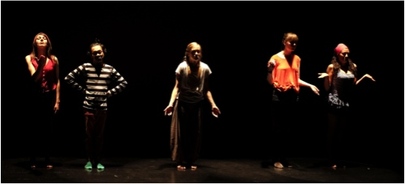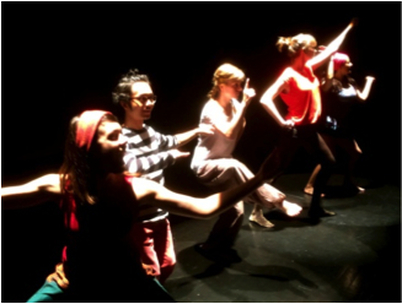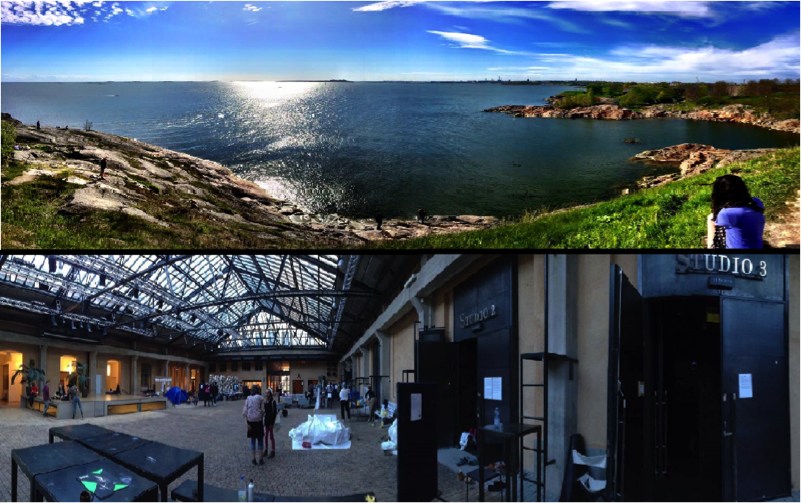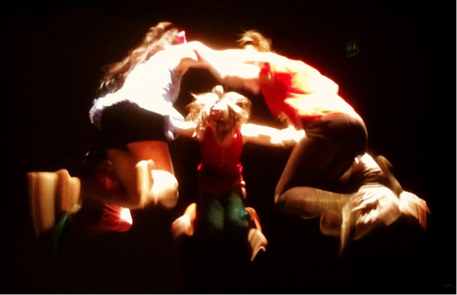Emerging : dance? through stories and stereotypes - About a collaborative movement performance11/4/2015 dance | her | his | story - LAPSody Live Art and Performance Studies Festival, Helsinki, 27-30 May 2015 A (retro)perspective by Signa Schiavo-Campo Premise – Choreomundus is a two years long International master in Dance Knowledge, Practice and Heritage. It is part of the Erasmus Mundus MA programs financed by the European Union. The master looks at movement systems and practices (dance, rituals, martial arts, physical theatre, games, etc.) through the lens of different approaches, such as ethnochoreology and anthropology of movement, and includes a focus on intangible cultural heritage and safeguarding tools and plans. Choreomundus was run for the first time in 2012 with a first group, cohort 1. I enrolled in this MA in 2013 and graduated in June 2015 with the second cohort. This article is about a collaborative performance, dance | her | his | story, that was created by a group of Choreomundus students- cohort 2- and presented in May 2015 at the LAPSody Live Art and Performance Studies Festival in Helsinki. The performance aimed to investigate some of the issues we dealt with in the course of the program but in an embodied and performative way. This account is told from a personal point of view in a diaristic style and wish to throw a glance on the experience of this particular creation process.  Choreomundus cohor 2 – NTNU University, Trondheim|Norway, August 2013 Choreomundus cohor 2 – NTNU University, Trondheim|Norway, August 2013 Choreomundus, cohort 2: eighteen people from fifteen different countries, coming from a varied range of movement and theoretical backgrounds. Personal stories, experiences and cultural ways carved in the flesh of their bodies. The variety of paths and people brought together through the frame of Choreomundus does not stop fascinating me. Paths which came across each other -crashing into each other modifying changing shapes leaving traces-. Flesh of cultures, flesh of thoughts and visions; bodies becoming permeable to let something be not the same after this encounter. What can it happen in putting together all these bodies, stories, paths and people? If all of them, with their own potential, are brought to collaborate in a common project dealing with movement, (dance? Maybe), body and culture? How can we foster the mutual integration, translation and bridging between theory and practice? How to express this encounter corporeally? These questions accompanied me through the adventure of Choreomundus and found a concrete form in a collaborative movement/dance research project: dance | her | his | story. I like to think back at this project as an “exploring site”: an attempt to investigate theoretical issues drawn from dance anthropology in an embodied and performative way. ‘In today’s globalized world many discussions and projects are emerging around the intention to preserve diversity of cultural heritage, and to safeguard disappearing traditions; to create archives and museum collections. But, how can we think about life cycles of a dance practice? Can we put dance into the museum? Do we need to keep dances alive? How: searching for the “authentic” or reinventing the “past”? Through fixing the form or by developing it? Can our dances and multiple experiences be brought to a dialogue for the emergence of something new, something shared? What would be this hybrid springing from this process of intertwining our stories and the heritage of our bodies?’ dance | her | his | story is a collaborative performance presented during the LAPSody Live Art and Performance Studies Festival - Helsinki, 27th-30th of May 2015. Not by chance the theme of the festival was Emergent, Emergence, Emergency. Five members of Cohort 2 met for three months in the beautiful studios of the University of Roehampton to bring together bits of Hungary, Belarus, Italy, Colombia and Philippines, traces of ballet, contemporary dance, Colombian, Hungarian, Filipino and Italian traditional dances, Japanese Noh theatre, ritual chanting. We playfully reflected on the stereotypes we embody and project on others as a result of our identification with a country or a culture, and explored our personal and our contaminated movement stories. How does a Filipino look like and how does his language sound; in which way does a Colombian or a Belarusian walk; how does an Italian or a Hungarian communicate with their hands? How does my dance look like if I combine it with my movements and her movements and his movements? How does it feel to take “traditional Filipino dance steps” and recombine them? To dance a Hungarian contemporary tribal folkish dance? And to create a new born hybrid dance and transmit it as the truly authentic “Alacsanas dance” from ancient communities? We proceeded without a unique already established leader or the external eye of a choreographer, rather chose to shift the lead role, so each one of us would take care of a topic and guide the others. The process was challenging: tensions arose, conceptions clashed, friendship trembled. The process was a huge open learning, deepening the knowledge of each other, “bridging” to and through each other. A Guide to: dance her | his | story Performers: Diana Teresa Gutiérrez Garcìa, Signa Schiavo-Campo, Olia Sosnovskaya, Kinga Szemessy, Bryan Levina Viray. With the collaboration of Oluwadamilare Adeyeri, Csaba Németh, and Deborah Williams, and the support of Jeremy Carter-Gordon and Shan Rann. Sections Intro: Installation – time lapses Enter the black box of the studio hall.  Five computers on white cubes around the room are projecting time lapses of our cities of origin. Fragments of Bogota, Budapest, Milano, Minsk and Manila running through the screens. You get closer and put on the headphones so you can listen to a Hungarian rock song, Belarus national anthem, an Italian trash song, a Colombian and a Filipino melodies accompany the images. You take of the headphones and five people with colorful dresses are around you, stretching, it seems, humming those songs. You go sit-down; the performance is about to start. 1. Songs Introducing you to a cultural? personal soundscape. Five distorted sentences, one form each of us, reproducing the sound of our mother tongue. Singing the first syllable of our names. A rhythmic song made by our cultural onomatopoeic way for calling somebody. 2. Voiceover Five people in a line. An voiceover says: “Step forward if the sentence is valid for you”. The automatic voice defining us by our identification numbers, gender, age, weight, status, occupations, backgrounds, past experiences, fears, values, hopes, feelings. We step forward into categories that sound like a border crossing interrogatory. Slowly the focus shifts to a personal level and we let emerge bits of ourselves, what we love, what we fear, what we experienced.  Gestures In a kind of pop culture style we show the gestures we culturally do to express some sentences: “you are late”, “what a smell”, “I don’t care”. We do them differently but we are much more similar than we think. Additionally, it can be seen that a same simple action, like lifting a leg, can have an incredible number of variations.  Statues How does a Colombian look like? We manipulate the bodies of each other creating the live statue that represents our cultural types according to our nationalities. We put Italian gestures on “the Italian body”, a Hungarian expression on the Hungarian one, a Belarusian posture on the Belarusian.  Walking We play with five different ways of walking drawn from the stereotypes on our cultures. We embody the soft Filipino, the Italian macho, the ill Hungarian, the depressed Belarusian and the sexy Colombian.  3. Collage A chaotic session: everything happening at the same time. Diana’s lifting her leg in a split like a ballerina, Bry is doing a Noh Theatre walk, Signa and Kinga are dancing a personal chain of movements in slow motion. Diana and Bry join with their own movement sequences and the rhythm gets very quick. Olia is in the foregroung showing the process of creation of our danced movement sequences, randomly composed by chosen movements from our traditional dances or cultural stereotypes and gestures. Is that dance? To where does it belong? Where are the boundaries? In between hazard, personal choice and cultural gaze.  4. Alalata Alalata is a Colombian dance accompanied by a song aimed for children play and dance. We dance it, we twist it inserting our own improvised dances with five different movement qualities, that we chose as a temporary “mark” of ourselves. As if to say, “Hey, that’s me, that my dance!”.  5. Islapinas and Csango These are the most choreographic or danced segments. Islapinas is an invented dance composed by movements of a traditional dance from Philippines. We substituted the original music with one composed specifically for that. Csango is a circle dance inspired by Hungarian folk dances, but introducing a sort of tribal atmosphere. The dance is highly rhythmic, fast, on a low level, with jumps and turns.  Closing Scene Lights are on now and the performers are looking at you who a few instants earlier were staring at the stage. “Now it’s your turn”: A voiceover is inviting the audience to follow the instructions, to experience a session of the performance spiritedly. Lights get off again and a short dance tutorial is projected and you get to know about the Alacsanas dance, an authentic ancient, yet hybrid and new made, dance from remote communities. You can learn it from the tutorial, if you wish.
24 Comments
9/12/2022 12:51:12 am
Really informative article, I had the opportunity to learn a lot, thank you. https://kurma.website/
Reply
9/12/2022 12:13:22 pm
Really informative article, I had the opportunity to learn a lot, thank you. https://odemebozdurma.com/
Reply
9/30/2022 03:18:35 pm
It's great to have this type of content. Good luck with your spirit. Thank you. https://bit.ly/site-kurma
Reply
10/4/2022 09:14:03 pm
I think this post is useful for people. It has been very useful for me. Looking forward to the next one, thank you. https://escortnova.com/escort-ilanlari/van-escort/muradiye-caldiran-escort/
Reply
10/6/2022 04:40:00 pm
I support your continuation of your posts. I will be happy as new posts come. Thank you. https://escortnova.com/escort-ilanlari/adana-escort/seyhan-escort/
Reply
10/7/2022 04:59:49 pm
I think the content is at a successful level. It adds enough information. Thank you. https://escortnova.com/escort-ilanlari/elazig-escort/agin-escort/
Reply
10/7/2022 10:39:04 pm
Thank you for your sharing. I must say that I am successful in your content. https://escortnova.com/escort-ilanlari/izmir-escort/kiraz-escort/
Reply
10/8/2022 08:45:44 pm
Thoughtful and real content is shared. Thank you for these shares. https://escortnova.com/escort-ilanlari/trabzon-escort/arsin-escort/
Reply
11/21/2022 02:36:41 pm
Tıkla evde calismaya basla: https://sites.google.com/view/evden-ek-is/
Reply
12/9/2022 02:53:42 pm
kaliteli düşmeyen takipçi satın al: https://takipcialdim.com/
Reply
12/9/2022 02:57:34 pm
instagram beğeni satın al: https://takipcialdim.com/instagram-begeni-satin-al/
Reply
12/15/2022 02:28:30 pm
takipçi satın al ve sitemizi ziyaret et: https://takipcim.com.tr/
Reply
4/28/2023 02:09:27 am
Anabolik Steroid Satın Al: https://www.anabolickapinda14.com/urun/
Reply
5/10/2023 07:32:15 pm
Heets Çeşitlerine Göz At: https://bit.ly/heets-heets
Reply
8/9/2023 03:56:14 pm
Steroid Siparis Steroid Fiyatlari Steroidler Anabolizan Orjinal Steroid Steroid Satis Steroid Satın Al Steroid Siparis Et
Reply
Leave a Reply. |
Disclaimer: The views and opinions expressed in all posts are those of the authors and do not necessarily reflect the views of the association or the MA program.
Authors
All
Archives
December 2021
|



 RSS Feed
RSS Feed
